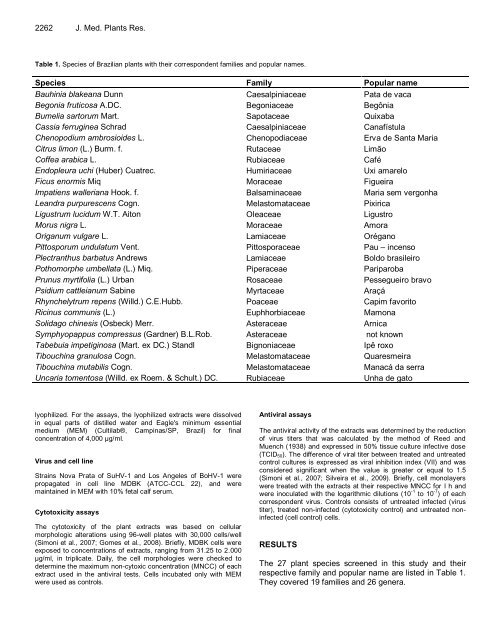Download Complete Issue - Academic Journals
Download Complete Issue - Academic Journals
Download Complete Issue - Academic Journals
You also want an ePaper? Increase the reach of your titles
YUMPU automatically turns print PDFs into web optimized ePapers that Google loves.
2262 J. Med. Plants Res.<br />
Table 1. Species of Brazilian plants with their correspondent families and popular names.<br />
Species Family Popular name<br />
Bauhinia blakeana Dunn Caesalpiniaceae Pata de vaca<br />
Begonia fruticosa A.DC. Begoniaceae Begônia<br />
Bumelia sartorum Mart. Sapotaceae Quixaba<br />
Cassia ferruginea Schrad Caesalpiniaceae Canafístula<br />
Chenopodium ambrosioides L. Chenopodiaceae Erva de Santa Maria<br />
Citrus limon (L.) Burm. f. Rutaceae Limão<br />
Coffea arabica L. Rubiaceae Café<br />
Endopleura uchi (Huber) Cuatrec. Humiriaceae Uxi amarelo<br />
Ficus enormis Miq Moraceae Figueira<br />
Impatiens walleriana Hook. f. Balsaminaceae Maria sem vergonha<br />
Leandra purpurescens Cogn. Melastomataceae Pixirica<br />
Ligustrum lucidum W.T. Aiton Oleaceae Ligustro<br />
Morus nigra L. Moraceae Amora<br />
Origanum vulgare L. Lamiaceae Orégano<br />
Pittosporum undulatum Vent. Pittosporaceae Pau – incenso<br />
Plectranthus barbatus Andrews Lamiaceae Boldo brasileiro<br />
Pothomorphe umbellata (L.) Miq. Piperaceae Pariparoba<br />
Prunus myrtifolia (L.) Urban Rosaceae Pessegueiro bravo<br />
Psidium cattleianum Sabine Myrtaceae Araçá<br />
Rhynchelytrum repens (Willd.) C.E.Hubb. Poaceae Capim favorito<br />
Ricinus communis (L.) Euphhorbiaceae Mamona<br />
Solidago chinesis (Osbeck) Merr. Asteraceae Arnica<br />
Symphyopappus compressus (Gardner) B.L.Rob. Asteraceae not known<br />
Tabebuia impetiginosa (Mart. ex DC.) Standl Bignoniaceae Ipê roxo<br />
Tibouchina granulosa Cogn. Melastomataceae Quaresmeira<br />
Tibouchina mutabilis Cogn. Melastomataceae Manacá da serra<br />
Uncaria tomentosa (Willd. ex Roem. & Schult.) DC. Rubiaceae Unha de gato<br />
lyophilized. For the assays, the lyophilized extracts were dissolved<br />
in equal parts of distilled water and Eagle's minimum essential<br />
medium (MEM) (Cultilab®, Campinas/SP, Brazil) for final<br />
concentration of 4,000 µg/ml.<br />
Virus and cell line<br />
Strains Nova Prata of SuHV-1 and Los Angeles of BoHV-1 were<br />
propagated in cell line MDBK (ATCC-CCL 22), and were<br />
maintained in MEM with 10% fetal calf serum.<br />
Cytotoxicity assays<br />
The cytotoxicity of the plant extracts was based on cellular<br />
morphologic alterations using 96-well plates with 30,000 cells/well<br />
(Simoni et al., 2007; Gomes et al., 2008). Briefly, MDBK cells were<br />
exposed to concentrations of extracts, ranging from 31.25 to 2.000<br />
µg/ml, in triplicate. Daily, the cell morphologies were checked to<br />
determine the maximum non-cytoxic concentration (MNCC) of each<br />
extract used in the antiviral tests. Cells incubated only with MEM<br />
were used as controls.<br />
Antiviral assays<br />
The antiviral activity of the extracts was determined by the reduction<br />
of virus titers that was calculated by the method of Reed and<br />
Muench (1938) and expressed in 50% tissue culture infective dose<br />
(TCID50). The difference of viral titer between treated and untreated<br />
control cultures is expressed as viral inhibition index (VII) and was<br />
considered significant when the value is greater or equal to 1.5<br />
(Simoni et al., 2007; Silveira et al., 2009). Briefly, cell monolayers<br />
were treated with the extracts at their respective MNCC for I h and<br />
were inoculated with the logarithmic dilutions (10 -1 to 10 -7 ) of each<br />
correspondent virus. Controls consists of untreated infected (virus<br />
titer), treated non-infected (cytotoxicity control) and untreated noninfected<br />
(cell control) cells.<br />
RESULTS<br />
The 27 plant species screened in this study and their<br />
respective family and popular name are listed in Table 1.<br />
They covered 19 families and 26 genera.

















